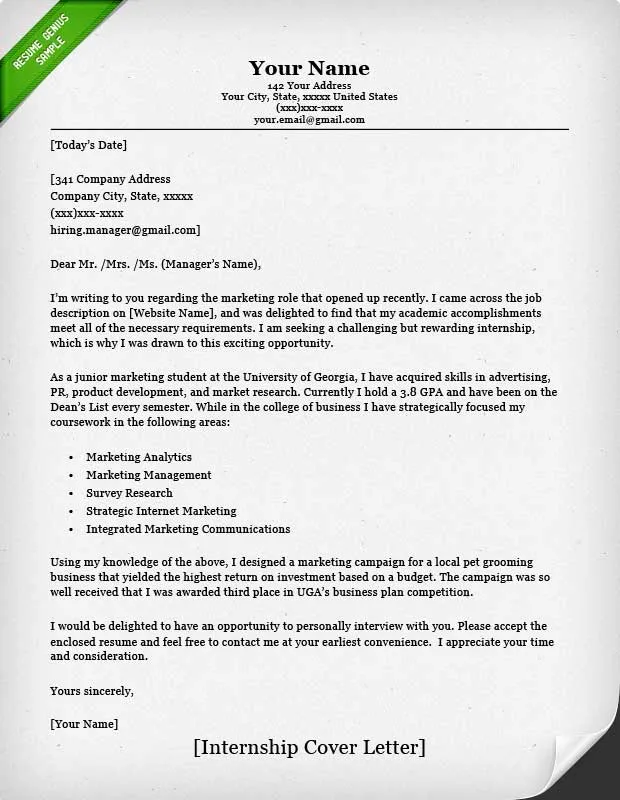Understanding the Internship Cover Letter
An internship cover letter is a crucial document that accompanies your resume when applying for an internship. It serves as your introduction to the potential employer, allowing you to showcase your personality, express your interest in the specific opportunity, and highlight the skills and experiences that make you a strong candidate. Unlike a resume, which provides a factual overview of your qualifications, a cover letter gives you the chance to tell a story, demonstrating how your aspirations align with the internship and the company’s objectives. A well-crafted cover letter can significantly increase your chances of securing an interview and ultimately, landing the internship.
Why is an Internship Cover Letter Important
A cover letter is important because it’s your first impression. It personalizes your application beyond the static details of a resume. It offers you an opportunity to connect with the hiring manager on a more personal level, expressing your genuine interest in the internship and the company’s mission. It allows you to demonstrate your written communication skills, which are vital in many professional settings. A cover letter lets you explain any gaps in your resume, such as a career change or taking time off for education. It helps you stand out from other applicants, especially in a competitive job market, showcasing your unique skills and experiences.
Key Components of a Cover Letter
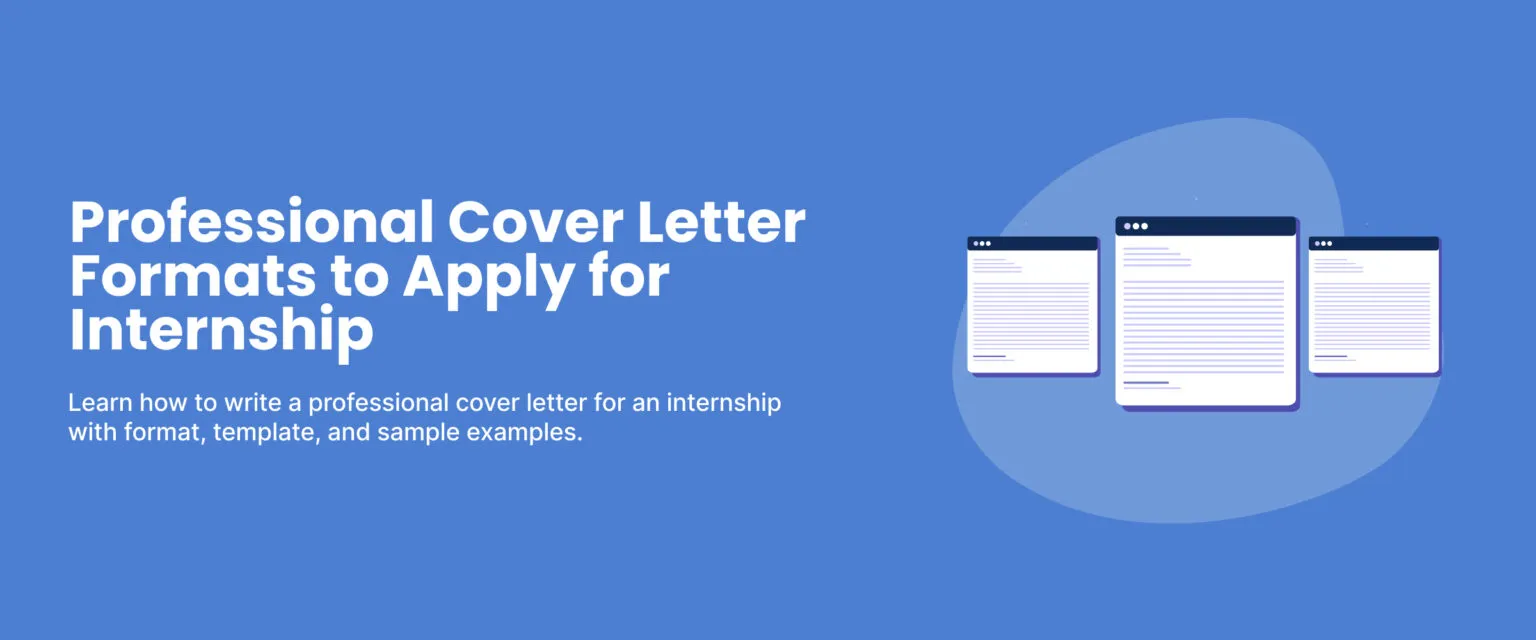
A strong internship cover letter comprises several key components that work together to create a compelling narrative. A clear and professional header, proper formatting, a compelling opening, detailed body paragraphs, and a strong closing are all necessary for a professional appearance. Each section contributes to conveying your qualifications, enthusiasm, and suitability for the internship position. Each part should be concise, well-written, and tailored to the specific internship you are applying for. By including all the essential elements, you’ll increase your chance of getting noticed by the hiring manager.
Header and Contact Information
Your cover letter header should include your name, address, phone number, and email address. This information should be at the top of the document, often left-aligned or centered. Below your contact information, include the date, the hiring manager’s name (if known), their title, and the company’s address. Ensure that all contact details are up-to-date and professional. This ensures that the recruiter has all the necessary information to contact you promptly. Correct formatting in this initial section sets the tone for the rest of your letter.
Proper Formatting
Proper formatting is essential for readability and professionalism. Use a standard font like Times New Roman, Arial, or Calibri in a size between 10 and 12 points. Maintain consistent margins (typically 1 inch on all sides) and single-space the body of your letter with a blank line between paragraphs. Use a clear and easy-to-read layout. Proper formatting makes your letter visually appealing and allows the hiring manager to easily find the important information. Proofread carefully to make sure there are no errors in formatting.
Salutation
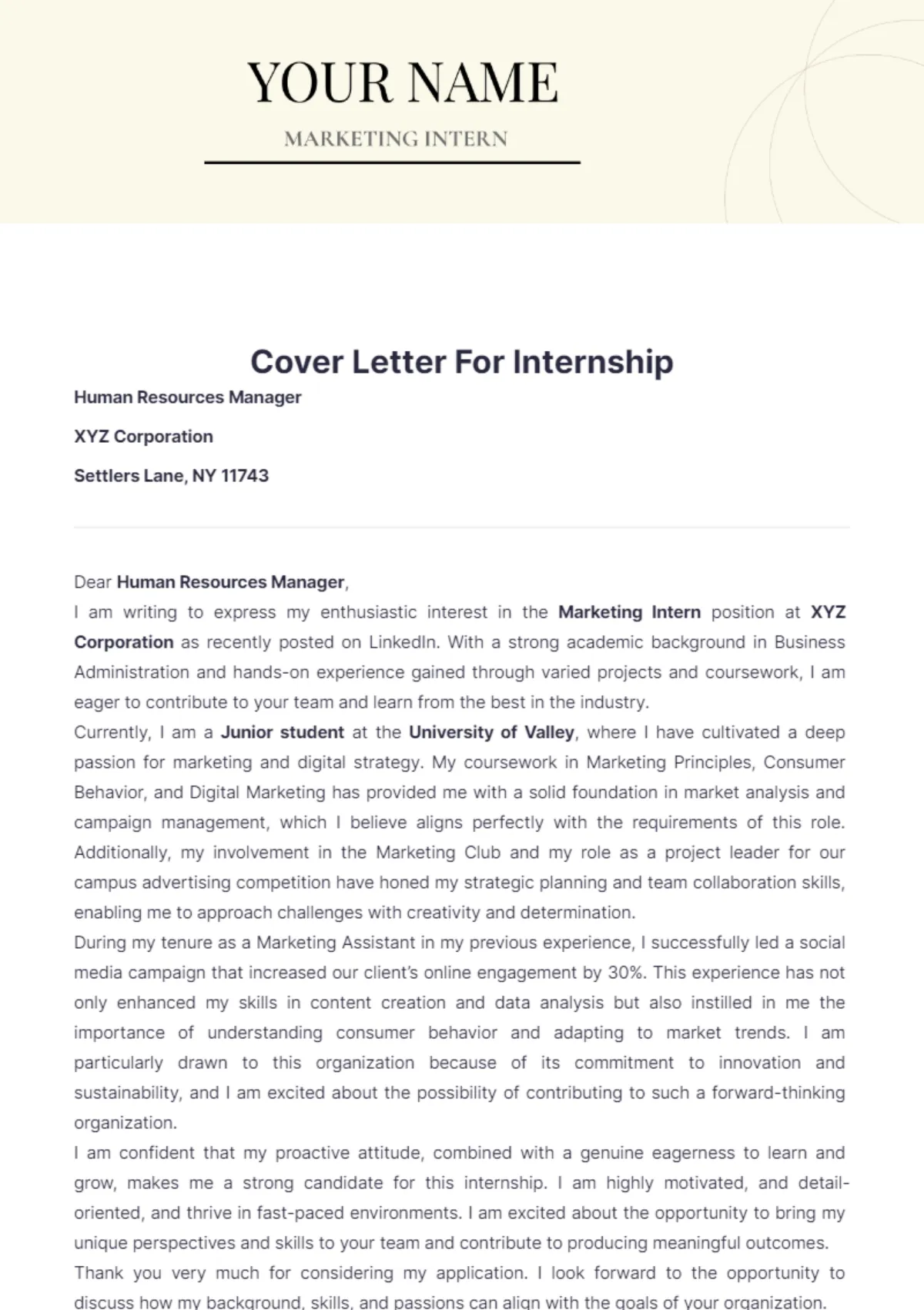
Begin your cover letter with a professional salutation. If you know the hiring manager’s name, use ‘Dear Mr./Ms./Mx. [Last Name]’. If you don’t know the name, use a general greeting such as ‘Dear Hiring Manager’ or ‘Dear [Company Name] Recruiting Team’. Avoid generic greetings like ‘To Whom It May Concern.’ Addressing the letter directly shows that you’ve taken the time to research the company and the position, creating a more personalized connection. This creates a positive first impression.
Body Paragraphs
The body paragraphs are the core of your cover letter, where you showcase your qualifications, skills, and enthusiasm for the internship. These paragraphs should be well-structured, concise, and tailored to the specific requirements of the internship. Focus on making a connection between your skills and the internship’s requirements, highlighting relevant experiences, and explaining why you are a good fit for the role. This section is where you demonstrate your written communication skills and make a case for why you deserve the opportunity.
First Paragraph Grab Attention
Your first paragraph should immediately grab the reader’s attention. Start with a strong opening statement that clearly states the position you are applying for and where you found the job posting. Express your enthusiasm for the internship and the company. Briefly mention why you are interested in this specific opportunity. Avoid generic openings and instead highlight something specific that caught your eye about the role or company. This is your chance to get the reader’s attention and motivate them to read on.
Second Paragraph Showcase Skills
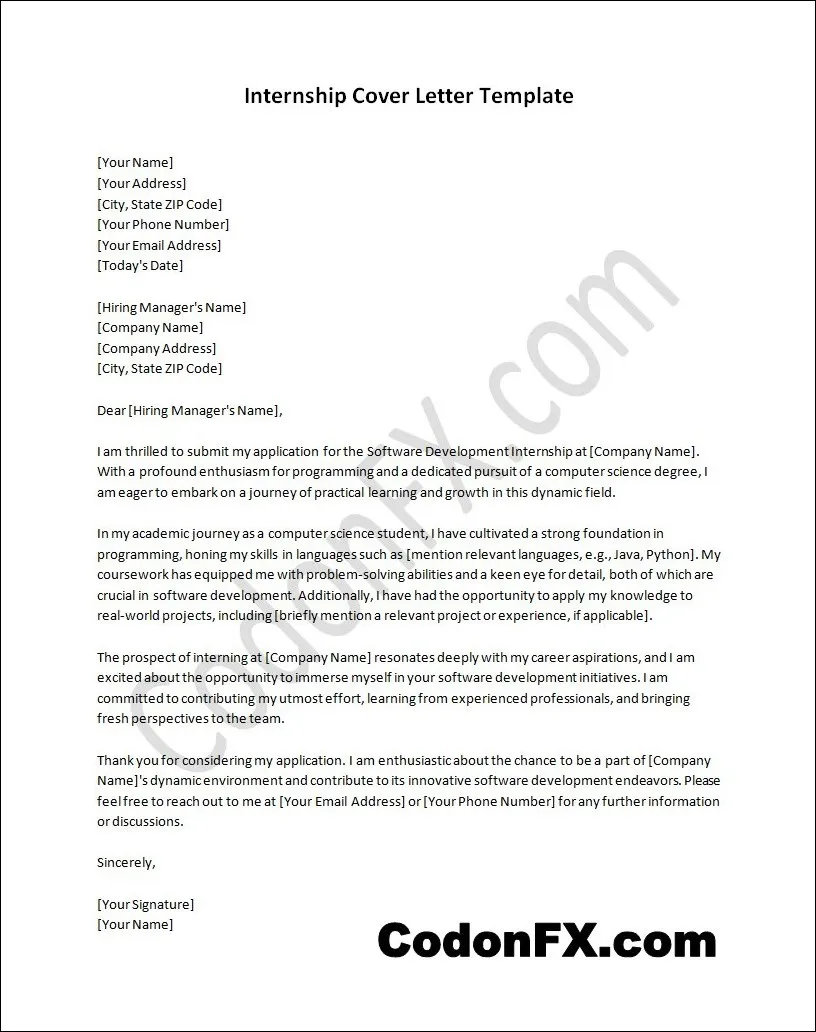
In your second paragraph, highlight your relevant skills and experiences. Refer to the job description and identify the key requirements the employer is seeking. Then, provide specific examples from your academic, professional, or volunteer experiences that demonstrate these skills. Use the STAR method (Situation, Task, Action, Result) to describe how you used your skills to achieve positive outcomes. Quantify your accomplishments whenever possible to demonstrate your impact. Be sure to tailor this section to the internship you’re applying for by emphasizing the skills and experiences most relevant to the role.
Third Paragraph Show Enthusiasm
The third paragraph allows you to express your enthusiasm for the company and the internship. Explain why you are specifically interested in working for this company and how the internship aligns with your career goals. Share any relevant experiences or knowledge you have about the company and its industry. Demonstrate your understanding of the company’s mission, values, and products or services. Show that you have done your research and that you are genuinely excited about the opportunity. This is where you create a personal connection and highlight why you would be a good fit for the company culture.
Call to Action
In your closing paragraph, include a clear call to action. Express your eagerness to discuss your qualifications further and reiterate your interest in the internship. Include a sentence that invites the hiring manager to contact you to schedule an interview or request additional information. Make sure to thank the reader for their time and consideration. This makes the closing more professional. A strong call to action shows that you are proactive and ready to move forward with the application process.
Closing and Signature

Close your cover letter with a professional closing. Use a formal closing such as ‘Sincerely,’ ‘Regards,’ or ‘Best regards.’ Leave space for your handwritten signature if you are submitting a physical copy or simply type your name below your closing. Ensure the tone of the closing matches the overall tone of your cover letter. A well-crafted closing leaves a lasting impression. This final step ensures your cover letter presents a polished and professional image.
Proofreading and Editing
Proofreading and editing your cover letter are absolutely essential. Errors in grammar, spelling, and punctuation can detract from your professionalism and credibility. Before submitting, carefully review your letter for any mistakes. Consider asking a friend, family member, or career advisor to review your cover letter for a second opinion. Ensuring your letter is free from errors shows that you pay attention to detail and that you are committed to excellence. This attention to detail helps you make a strong impression on the hiring manager.
Tailoring the Cover Letter
Tailoring your cover letter to each specific internship is critical for increasing your chances of success. Generic cover letters don’t demonstrate genuine interest and can make it seem as if you aren’t invested in the position. Tailoring shows that you’ve taken the time to understand the company’s needs. Your cover letter should be customized by researching the company, highlighting relevant skills and experience, and matching the job description. This will help you showcase your suitability for the role.
Researching the Company
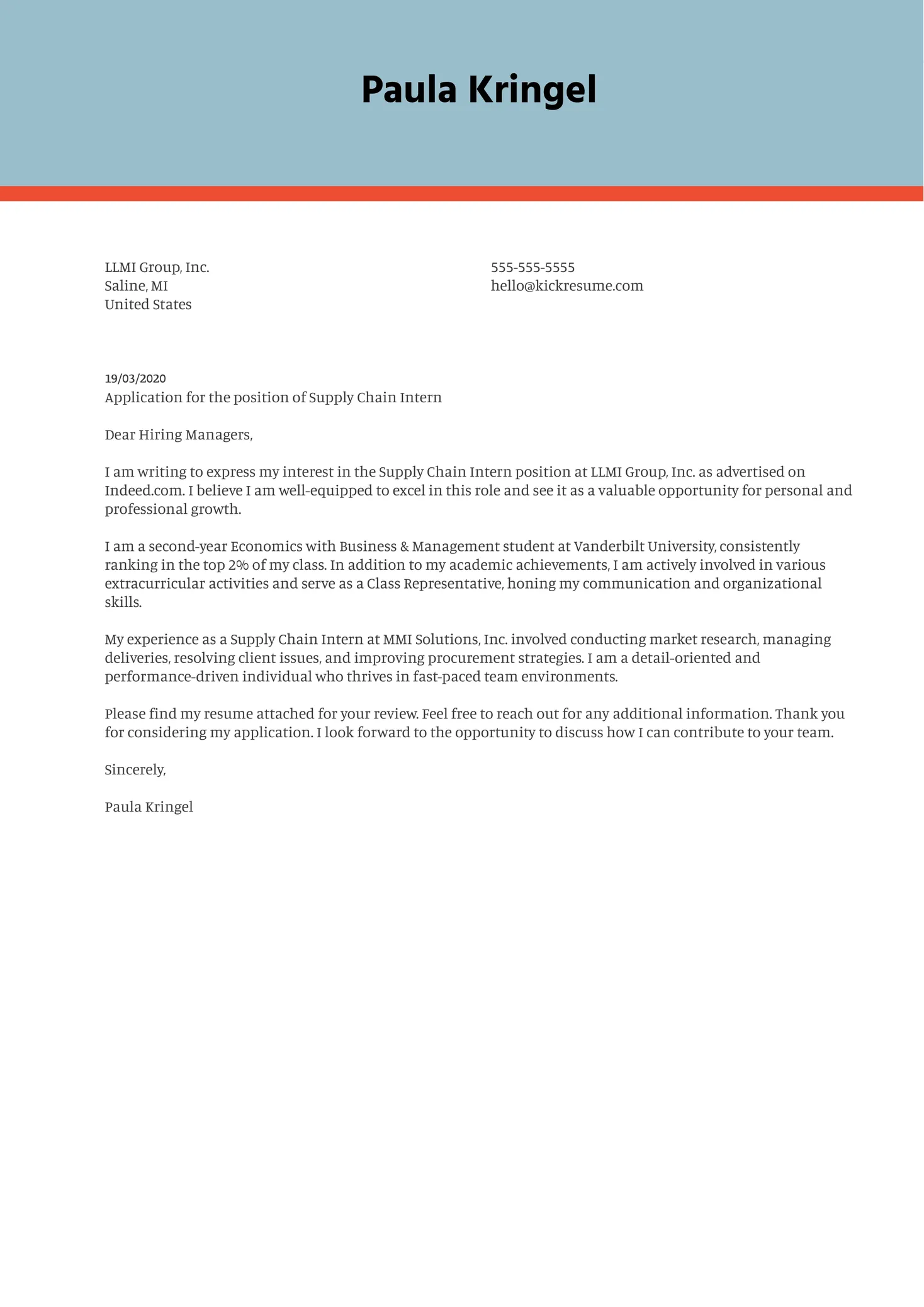
Before writing your cover letter, research the company thoroughly. Visit the company’s website, read their ‘About Us’ section, and explore their social media profiles. Understanding the company’s mission, values, products, services, and culture will help you tailor your cover letter to fit their specific needs. Mention specific aspects of the company that appeal to you, showing that you are genuinely interested in the internship and have done your homework. This research allows you to demonstrate your alignment with the company.
Highlighting Relevant Skills and Experience
Carefully review the job description and identify the skills and experiences the employer is seeking. Then, highlight the relevant skills and experiences from your background that match those requirements. Give specific examples to show how you have demonstrated these skills in the past. Tailor the examples to the specific internship and company. Focus on how your skills and experiences align with the requirements and demonstrate your ability to contribute to the company’s goals. This targeted approach demonstrates your suitability for the role.
Matching the Job Description
Use the job description as a guide when writing your cover letter. Carefully analyze the key requirements and keywords mentioned in the job posting. Use these keywords strategically throughout your cover letter to show the employer that you possess the skills and qualifications they are looking for. Ensure you address each of the key requirements mentioned in the job description. This helps demonstrate you understand the position and are a strong match. By directly addressing these requirements, you make it easy for the hiring manager to see how you fit their needs.
Formatting Tips and Best Practices
Proper formatting enhances the readability and professionalism of your cover letter. Use these tips to create a polished and impressive document. Pay close attention to your font choice, margins, spacing, and file format. Following these best practices ensures your cover letter is both visually appealing and easy to navigate.
Font Choice and Size
Select a professional and readable font, such as Times New Roman, Arial, or Calibri. Stick to a font size between 10 and 12 points. Avoid using overly decorative fonts or sizes that are difficult to read. Choose a font that is clear and easy to scan. Consistent font choices and sizes provide a professional look. A readable font makes your cover letter more accessible to the hiring manager.
Margins and Spacing
Set your margins to 1 inch on all sides. Use single-spacing within paragraphs and double-spacing between paragraphs. Ensure the document is well-formatted. This creates a balanced and uncluttered appearance. Proper spacing improves readability, making it easier for the hiring manager to quickly absorb your information. Make sure the spacing makes your letter easy to read.
File Format and Naming Conventions
Save your cover letter as a PDF file to ensure that the formatting remains consistent across different devices and operating systems. Name the file using a clear and professional naming convention, such as ‘YourName_CoverLetter_CompanyName’. This makes it easy for the hiring manager to identify your document. Using the PDF format guarantees that the format will not change. Following these guidelines will help your application stand out.
